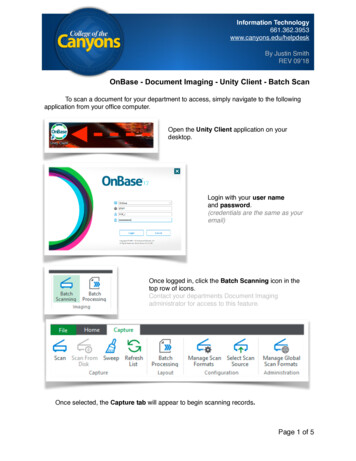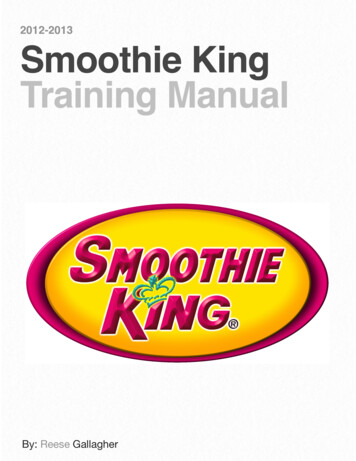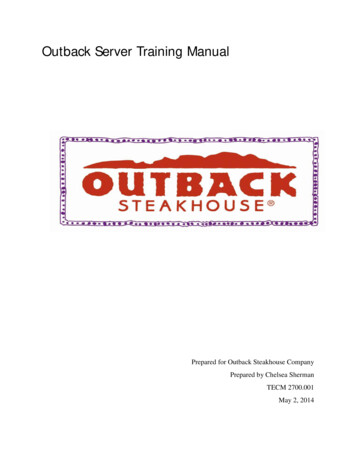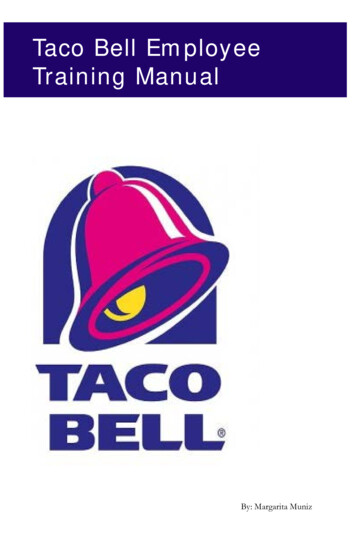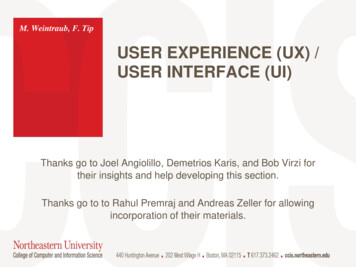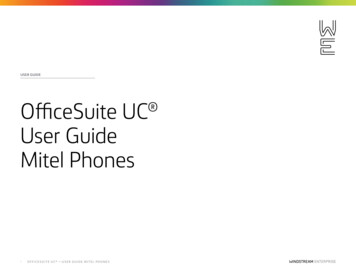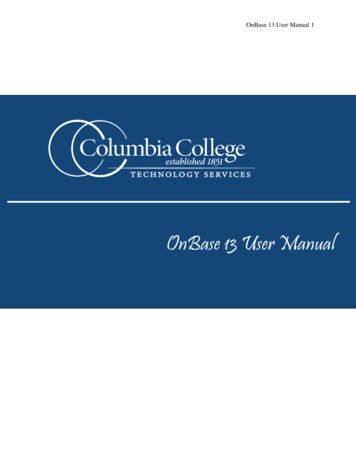
Transcription
OnBase 13 User Manual 1OnBase 13 User Manual
OnBase 13 User Manual 2Table of ContentsOnBase is the document imaging and archiving software that replaced Singularity in 2012. The softwareis maintained by a company called Hyland. Using Hyland’s OnBase application, workflows and processescan be customized for different offices, departments, and campuses, allowing for increased efficiency andeffectiveness.If you are viewing this document as a PDF, you may click on the headings below to navigate directly tosections of the manual.ContentsLogging in to OnBase . 4Navigation . 4The Ribbon. 4The Home Tab . 5The Application Menu . 8Layout . 8The Task Pane . 8Processes in OnBase . 8Scanning Documents . 8Scan Formats:. 9Uploading Documents from Disconnected Scanning . 10Processing Documents . 10A Note on Scan Queues . 11Appending Documents. 11Splitting Documents. 12Re-Indexing Documents . 12Document Retrieval . 13Uploading Documents from your Computer . 13Appending Documents via Upload . 13Using the Virtual Print Driver . 14Sending Documents via Email . 14The Notes Gallery . 15Annotations . 15Notes in the Document Viewer . 15
OnBase 13 User Manual 3Working with Images . 16Working with Keywords . 17Viewing Keywords . 17Read Only Keywords . 18Wildcard Characters. 18The Application Enabler . 18Customizations in the Unity Client . 18Personal Pages . 18Adding Document Types to your Personal Page . 19Creating Personal Page Tiles with Custom Queries . 19Adding Forms to Personal Pages . 19Customizing User Options . 20
OnBase 13 User Manual 4Logging in to OnBaseOnBase is accessed through an application often referred to as the Unity Client. This terminology simplyindicates that the software program has been downloaded to the computer, as opposed to being stored in aweb-based environment. To log in to OnBase:1. Navigate to the computer’s Start Menu and selectStart.2. Choose All Programs.3. Choose Hyland.4. Choose Unity Client.NOTE: When accessing the Unity Client, users will viewoptions for accessing Hyland Unity Client [TEST] andHyland Unity Client [PROD]. Please be sure to access thecorrect version.5. Enter the user’s credentials in the dialog box and select Login.6. The Unity client will now open.NavigationThe OnBase Unity Client window has three primary areas: the layout, the ribbon, and the task pane.TASKPANERIBBONTheRibbonThe ribbondisplaysavailableuseractionsbased onthecurrentlydisplayed layout. A ribbon is displayed by clicking on the corresponding tab. Each tab is divided in toribbon groups, or categories of user actions.
OnBase 13 User Manual 5The Home TabI n the image above, the Home tab is displayed. The Home tab is visible after logging in to OnBase. Likeother tabs, the Home tab is divided into ribbon groups. The Home tab displays several commands,summarized below.NOTE: Users can minimize the ribbon by right-clicking on the ribbon and selecting Minimize theRibbon. Users can maximize the ribbon by right-clicking and choosing the same option.The Favorites GroupThe Favorites group is used to open andconfigure the home layout and favorites.HomeUse these options to: Make the currentlydisplayed layoutthe home page Reset the layoutthat is displayed asHome to thedefaultPersonal PageThe Personal Pagecommand allows usersto view and edit theirPersonal Page.FavoritesUse these options to: View, rename, anddelete layouts thathave been added tofavorites Add the currentlydisplayed layout toFavoritesThe Documents GroupThe Documents Group is used to work withdocuments once they have been scanned,indexed, uploaded, or printed in to OnBase.
OnBase 13 User Manual 6Custom QueriesCustom Queries allowsadministrators to buildand modify customsearch criteria.RetrievalUse the Retrievalcommand to bringdocuments into theUnity Client once theyhave been scanned andindexed.The Create GroupThe Create Group is used to work with thecreation of documents in the Unity Clientvia upload from your computer, as well asworking with HTML Unity Forms.Working with formsallows users to developmore detailed, personalcustom queries relatedto specific documentswithin the system.FormsChoose the Uploadcommand to uploaddocuments into theUnity Client from yourcomputer.UploadThe Workflow GroupThe workflow group will be available forUnity Client users who have permission toview projects within workflows.By selecting theWorkflow command,users will be able toview the workflows oftheir specificdepartment.Departments areresponsible for trainingemployees onworkflow processes.
OnBase 13 User Manual 7The Imaging GroupThe Imaging Group assists users inimaging, scanning, and processing files.Batch ProcessingSelect BatchProcessing to imagefiles after they havebeen scanned. NOTE:In previous versions ofthe Unity Client, thiscommand was calledBatch Indexing.
OnBase 13 User Manual 8The Application MenuSelect the Application button in the upper left-hand corner of the Unity Client window to accessadministrative functions and open previously used layouts. After clicking the Application button, theApplication Menu is displayed. Selecting Open in a NewWindow allows the user to open thecurrent layout or search results in a newwindow. The Troubleshooting optionallows the user to show troubleshootinginformation such as the information onthe connection to OnBase, renderinginformation, and memory usage as wellas viewing and clearing the request log. Choose User Options toconfigure options within OnBase such as settings for imaging, printing, and document handling.Selecting Administration allows the user to manage document locks.Users can change their OnBase password by selecting Change Password; however, since ColumbiaCollege users log in to OnBase with their CougarTrack credentials, the Reactivate your Login toolin CougarTrack is a better option for password maintenance.LayoutEach screen in the OnBase Unity Client is referred to as a layout. Default layouts are set for most of theactions in OnBase, including Document Retrieval. OnBase will open the Home Layout by default whenthe application is launched, but users are able to customize the Home Layout.The Task PaneThe Task Pane is displayed in relation to the user action. For example, selecting the Keywords option onthe Document contextual tab displays the Add/Modify Keywords task pane.Typically, the task pane is used to view some information that will be displayed briefly and then closed. Itis also used for tasks such as adding documents to an envelope, displaying a document’s keywords, notes,and cross references, or managing Favorites.Processes in OnBaseScanning Documents1. To begin scanning documents, open the Disconnected Scanning software by choosing Hyland fromthe Start Menu and selecting Disconnected Scanning.
OnBase 13 User Manual 92. Enter the user’s credentials inthe Disconnected Scanninguser logon dialog box.3. Select Server to log in to theDisconnected Scanning server.NOTE: ccdiapp02.ccis.edu is theserver address for OnBase Test.To log into OnBase production,enter ccdiapp.ccis.edu as theserver address.4. Select OK in the Userauthentication dialog box tolaunch the DisconnectedScanning application.5. Select a Scan Queue, Source,and Format before attempting to scan.Scan Formats:Simplex: Multi-Document/Single PageEach one-sided page in the batch is scanned as aseparate document.Duplex: Multi-Document/Single PageEach two-sided page in the batch is scanned as aseparate document.Simplex: Single Document/Multi PageThe one-sided document is scanned as a multiplepage document.Duplex: Single Document/Multi PageThe two-sided document is scanned as a multiplepage document.NOTE: It is recommended to use the Multi-Document/Single Page format for most scanning projects.6. Place the document(s) in the scanner face down.7. Select File.
OnBase 13 User Manual 108. Choose Scan new batch.9. Dedicate a name to the batch and choose OK.10. The Properties dialog box will open. Ensurethat:a. The page size is listed as Letter- 8.5 x11 inb. The Dots per inch is listed as 200 dpic. The Scanning Side is listed as Simplex.11. The document will be scanned and a previewwill be displayed on the screen.12. When the document has completed scanning,choose Cancel.13. To scan additional documents into the currentbatch, choose Scan More Pages.14. When the documents have finished scanninginto the batch, choose Done.Uploading Documents from Disconnected ScanningOnce the batch has been scanned using the Disconnected Scanning Software, it must be uploaded into theUnity Client. To do so:1. Locate the batch in the navigationtree within the navigation pane onthe left side of the screen.2. Right click on the batch and chooseUpload Batch.3. The Verify Operations dialog boxwill display.4. Click Yes.5. The batch will now upload into theUnity Client. To continue workingwith it, open this application.Processing DocumentsOnce documents have been uploaded into the UnityClient, they will need to be indexed. Indexingdocuments moves them into the document archive inthe Unity Client so they will be available for retrievallater.1.2.Log in to the Unity Client.From the Home tab, choose Batch Processing.
OnBase 13 User Manual 113. Choose the appropriate scan queue for the batch. It is no longer necessary to select Awaiting Indexfrom the Status Queues and then select your scan queue. Click directly on the scan queue.Note that scan queues and status queues now appear in a navigation tree on the left side instead of statusqueues being located across the top.4. Locate the file in the existing batches and double click on the batch name to view and preview thedocuments in the batch.5. After previewing the batch, click the green arrow next to the batch name to return to the Scan Queuelist.6. The batch has now been previewed and is ready for indexing. Right-click on the batch name and clickIndex Documents.7. In the Batch Indexing pane, choose a document type. The fields below may take a moment topopulate, as they are document type specific.8. Associate a COMM Code and a Datatel Person ID with the document. Press Tab on the keyboard toauto-populate the remaining fields.9. To index the batch, click Index.A Note on Scan QueuesWhen batches are indexed in the Unity client, they may take up to five minutes to commit. When usersaccess scan queues within Unity, they will notice the batches are sorted into different categories: Awaiting Index: Documents that have been scanned with Disconnected Scanning and need tohave keyword values associated prior to indexing.Index in Progress: Documents that are currently indexing.Awaiting Commit: Documents that need to be committed to the system. Documents can take upto five minutes to be committed to the system.Committed: Documents that are available for retrieval in the Unity Client.Incomplete Disconnected Scan: Batches are placed in to the Incomplete Disconnected Scanprocess queue when a batch upload from Disconnected Scanning cannot be completed.If a user is unable to locate a batch within retrieval, it is likely due to the batch not having beencommitted. If the user is able to locate the document in the Awaiting Commit queue, wait the requisitefive minutes and attempt to index the document.Appending DocumentsWhen users are indexing documents in the Unity Client, they have the ability to append, to append, orjoin documents together. To do so:1. Click Batch Processing from the Home tab on the ribbon.2. Select a scan queue and a document to be indexed.
OnBase 13 User Manual 123. Right click on the batch to be indexed and click Index Documents.4. Associate a document type and keywords with the document in the task pane.5. Click Index.6. After the document has been indexed, a greencheck mark will appear next to it in the documentpane.7. Select the next document from the documentpane. Associate a document type and keywordvalues with the document.8. Click Append. This will join the seconddocument to the first when it is indexed.9. A green check mark will appear next to the appended document.10. Continue to append all relevant documents in the batch.Splitting DocumentsIn addition to adding additional pages to already indexed documents, the Unity Client offers the abilityfor users to removed pages from document and create a separate document, referred to as splitting thedocument. To do so:1. Open a document. Select the first page of the document to re-index.2. Right click on the document and choose Send To.3. Click Create New Document. In the Create New Document dialog box, enter indexinginformation regarding the new document.4. Click OK.5. A new document will be created from the pages indicated in the Create New Document dialogbox. These pages will be deleted from the original document by default.Re-Indexing DocumentsOccasionally, documents may become associated with incorrect keyword values or the wrong documenttype. To change these items, the document will need to be re-indexed. To do so:1.2.3.4.5.Open the document in the document viewer.In the ribbon, click Re-Index.The Re-Index task pane will open on the right side of the screen.To change the Document Type, select a new option from the Document Type drop down menu.To associate the document with a different individual, type the new ID number in the Datatel PersonID field.6. Press the Tab key on the keyboard to auto-populate the remaining keyword values.7. After the necessary changes have been made, click Re-Index.
OnBase 13 User Manual 13Document RetrievalThe document retrieval process assists users in locating, viewing, and manipulating documents that havepreviously been indexed. To retrieve a document:1. Select Retrieval from the Home tab on the ribbon. The Document Retrieval layout will open.2. Choose a document type. To search for all document types associated with an index value, selectany document type and hold down the Control key and the letter A on your keyboardsimultaneously.3. Enter the index values associated with the document to be located. Enter the College ID numberin the Datatel Person ID field and press the Tab key on the keyboard to auto-populate theremaining fields.4. Click Find to locate all the documents associated with the specified document type and indexvalues.5. Locate the document in the Search Results pane and double click on the document to view it.Uploading Documents from your ComputerUsing the Unity Client, users have the option to upload documents from their computers as an alternativeto using the scanning process (the equivalent to using the Import function in Singularity). To do so:1. Select Upload from the Home tab on the ribbon. This will openthe Upload Contextual tab.2. Select Browse from the ribbon.3. Locate the document to upload and choose Open.4. Using the Upload layout, associate a document type and indexvalues with the document.5. Choose Upload.6. The Unity Client will confirm the document has been uploaded and the document will open in theDocument Viewer.Appending Documents via UploadWith Unity Client 13, users are able to append to existing documents via the Upload command.1.2.3.4.From the Home tab on the ribbon, click Upload.Select Browse from the ribbon and locate the document to be uploaded. Click Open.Choose a document type and keyword values and select Upload.If the document is recognized by the system as possibly being an addition to an existingcommitted document, the system will present the following message: This document appears tobe related to an existing document. If so, please select the original document and select theappropriate option below.
OnBase 13 User Manual 145. Choose the document from the left hand navigation pane to whic
OnBase 13 User Manual 2 Table of Contents OnBase is the document imaging and archiving software that replaced Singularity in 2012. The software is maintained by a company called Hyland. Using Hyland’s OnBase application, workflows and processes can be customized for different offices, departments, and campuses, allowing for increased .File Size: 1MB

